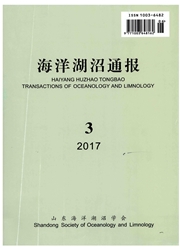

 中文摘要:
中文摘要:
分析了2009年夏季(8月)、冬季(12月)辽东湾25个大面站的网采浮游植物的物种组成,群落结构及其与环境因子的相关性。经初步分析,共鉴定出浮游植物3门48属108种,其生态类型主要为温带近岸的世界广布种,硅藻是浮游植物的主要类群,但个别甲藻在冬季也成为优势种。夏季优势种主要为菱形藻(Nitzschia spp.)、长菱形藻(Nitzschia longissima(Breb.)Ralfs)、虹彩圆筛藻(Coscinodi scusoculus—iridis Ehrenberg)。冬季优势种主要为威氏圆筛藻(Coscinodiscus wailesii Gran & Augst)、具槽帕拉藻(Paralia sulcata(Ehr.)Cleve)、布氏双尾藻(Ditylum bright—wellii(West)Grunow)、圆筛藻(Coscinodiscus spp.)。2009年夏、冬季浮游植物的物种组成和优势种组成存在季节差异,说明浮游植物群落结构随季节发生变化。浮游植物细胞丰度表现出沿岸高于远岸,且夏、冬季平均细胞丰度均明显低于同期历史数据的特点。2009年夏、冬季平均香农一威纳指数均大于3.0,平均Pielou均匀度指数均犬于0.5,说明调查海域群落结构相对稳定,种间个体数目空间分布较均匀;夏季丰富度指数高于冬季,表明夏季较冬季物种丰富。冬季调查区各站位浮游植物群落相似性在50%以上;夏季群落相似性水平低于冬季。2009年夏、冬季浮游植物细胞丰度变化的主要影响因素是温度。
 英文摘要:
英文摘要:
The species composition, the community structure and its correlation with the environmental factors in Liaodong Bay in summer (August) and winter (December)of 2009 were analyzed using the net-phytoplankton data from 25 grid stations. In our preliminary analysis, a total of 108 taxa which belong to 48 genera of 3 phyla were identified in the survey area. The majority of species were neritic and cosmopolitan in temperate coastal seas. The diatom was the main group of the phytoplankton, but some dinoflagellates became the dominant species in winter as well. The dominant species in summer included Nitzschia spp. , Nitzschia longissima (Breb.)Ralfs, Coscinodiscus oculus-iridis Ehrenberg while the dominant species in winter were Coscinodiscus wailesii Gran Augst, Paralia sulcata (Ehr.) Cleve, Ditylum brightwellii (West) Grunow, Coscinodiscus spp. The differences of species composition and the dominant species between seasons indicated that the community structure of phytoplankton varied with seasons'. The cell abundance of net-phytoplankton showed a decline trend from the coastal areas to the offshore areas in summer and winter, the average value of which was obviously lesser than the historical data among the same season. The average Shannon-Wiener index was larger than 3.0, the average Pielou uniformity index was larger than 0.5 in the summer and winter of 2009, which showed the species community was relatively steady and the spatial distribution of individual number interspecies was uniform in the investigated sea area. Species richness index in summer was larger than that in winter, which demonstrated the species in summer was richer. Phytoplankton community similarity in winter was above the level of 50% and much larger than that level in summer in the investigated area. Temperature was the main effect on the cell abundance of phytoplankton in the survey area in summer and winter of 2009.
 同期刊论文项目
同期刊论文项目
 同项目期刊论文
同项目期刊论文
 期刊信息
期刊信息
